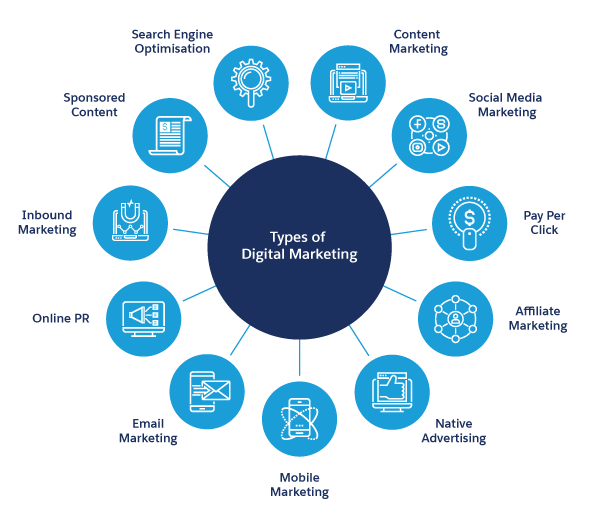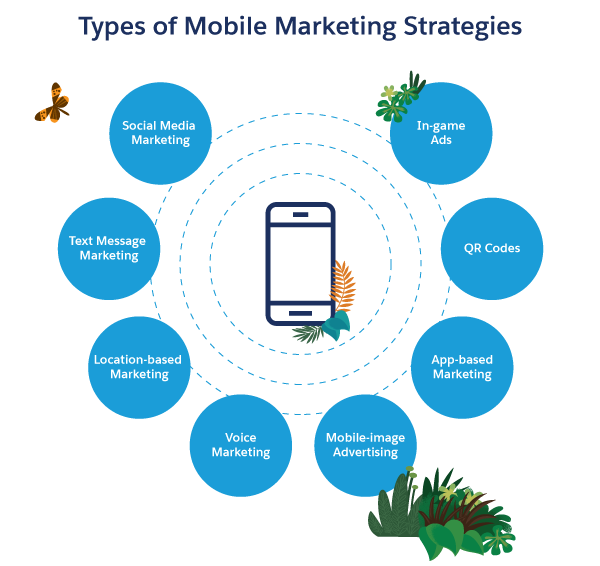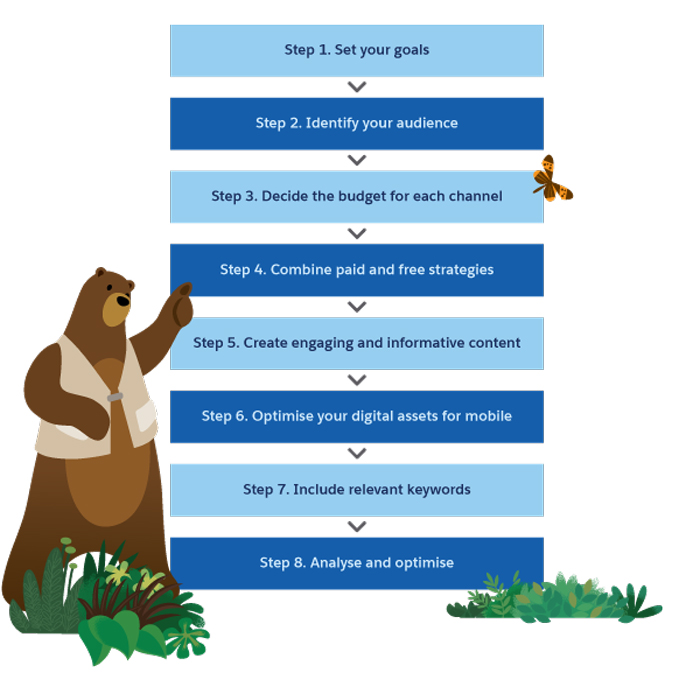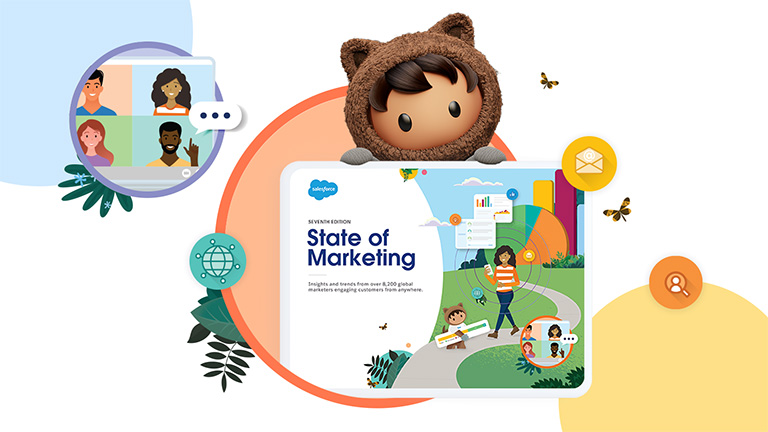Table of Contents
How does a business define digital marketing?
The top five benefits of digital marketing
Challenges in digital marketing
Digital Marketing strategies – what should you keep in mind?
How do you plan a digital marketing strategy for your business?
Successful digital marketing campaigns to inspire you
What is the role of a digital marketing manager?
Digital marketing for business growth
Make digital marketing count with Salesforce
Not too long ago, our use of electronic gadgets was restricted to just a handful of devices.Today, our lives are practically governed by the internet, and more precisely, by internet-enabled gadgets. The rapid internet penetration and ease of availability of internet-enabled devices have made sure that human experience in the real world is largely governed by the virtual/digital world.
From educational purposes to finding jobs, consuming entertainment, shopping, and even socialising - we do it all online. No wonder then, a significant chunk of the developed world is ‘constantly online’. Even in India, individuals spend an average of seven hours daily using the internet. This has also led to significant changes in how people interact with brands, paving the way for the rise of digital marketing.
But exactly what is digital marketing?
What is digital marketing?
How does a business define digital marketing?
Digital marketing for businesses is engaging with present and potential customers and promoting the business online through various channels such as social media, websites, emails, search engines, and even text and multimedia messages.
Unlike traditional offline marketing activities, which can be limited in their scope, digital marketing offers ample room for strategic thinking, resource optimisation, , and tracking the performance of these activities to further boost marketing efforts.It also enables businesses to target focused groups of customers, instead of using traditional marketing methods based on carpet-bombing. This makes digital marketing more effort- and cost-effective. Let’s look at some of these benefits of digital marketing for businesses in detail.
The top five benefits of digital marketing
1. Wider reach
2. Hyperlocal penetration
3. Easier personalisation and targeting
4. Better customer connection
5. Higher conversions
Like all marketing activities, timing is everything, and digital marketing offers simple ways to get timing right. Potential customers are more likely to engage with your brand when they are shown the right content at the right time. With enhanced personalisation, relevant messaging, and better reach, your efforts will yield a greater percentage of conversions. Plus, digital marketing helps you identify quality leads that are more likely to purchase your products. Better leads mean more conversions.
Given that digital marketing is more effective in helping businesses reach their desired audience, convert more leads, enable highly personalised content, and generate better ROI, it can be called the present and future of marketing.
Types of digital marketing

1. Search Engine Optimisation (SEO)
2. Content Marketing
3. Social Media Marketing
4. Pay Per Click (PPC)
5. Affiliate Marketing
6. Native Advertising
7. Mobile Marketing

8. Email marketing
9. Online PR
10. Inbound Marketing
11. Sponsored Content
Sponsored content is a type of paid advertising where content in different formats (blogs, infographics, social media posts, podcasts, webinars, events, videos, etc) is produced and distributed on different platforms. They are usually published with the ‘sponsored content’ tag, as native advertisements, but differ in their focus – which is shaped around delivering value, as opposed to selling the product or service.
Clearly, digital marketing offers multiple avenues to promote and grow your business. However, the effectiveness of these strategies, and how you use them, also depend on how well you overcome the challenges that follow. Although most brands want to use digital marketing to achieve the same goals, the difficulties they face can vary. One brand may struggle to generate enough social media traffic for their website, while another may not be able to calculate the return on investment for their most successful channel. Businesses need to fully comprehend the obstacles in their digital marketing efforts and then apply the right mix of strategies to reach their desired goals.
Challenges in digital marketing
The Covid-19 pandemic shuttered several brick-and-mortar businesses around the world, while playing a major role in expediting their shift to the online space. Marketing teams were compelled to turn to digital means, which meant dealing with a relatively steep learning curve. As more companies shift to digital marketing methods, consumers are inundated with competing ads, making it more difficult for brands to hold on to the customer’s attention.
Therefore, a primary challenge is to make your brand stand out in the crowd - by deploying marketing strategies that can effectively communicate your product’s USP to the target audience. Another hurdle is to create quality leads in a cost-effective manner. For this, you need to create a digital infrastructure that captures specific customer data while also offering value to your customers. Figuring out how to use complex digital tools is another barrier; this can be resolved through upskilling and training initiatives for marketers.
Since there are several platforms and formats available to a digital marketer, creating the right content in the right format and publishing it on the right platform at the right time is in itself a challenge. To overcome this, you need to be well-versed with the nuances of different types of marketing strategies and utilise these correctly for a successful marketing outcome.
Digital marketing strategies – what should you keep in mind?
What is a digital marketing strategy? Simply put, it is a plan that uses different platforms and content formats to achieve business goals. The purpose of digital marketing tactics is to raise brand awareness for your company, draw in new clients and increase sales. A strong strategy helps create an online presence for your brand using social media, sponsored search, organic search, websites and more. It considers your resources - personnel, time, and money - and understands the audience and their preferred channels. The idea is not to spread yourself thin on all channels but rather to have a strong presence on those platforms that a majority of your customers frequent.
Instead of creating content for all platforms at once, it’s best to focus your efforts on experimenting with content on specific channels that work well for you, monitoring your brand's performance on these, and optimising your efforts on the platforms which give you best results.
For example, if you’re a recruitment/headhunting agency, you are better off advertising on a platform such as LinkedIn, which is a ‘professional’ social media site. As a luxury boutique, your business could look at platforms such as Instagram and Pinterest. For unique products, search engine marketing may be your go-to option. For everything else, Facebook and Google serve as all-purpose platforms.
How do you plan a digital marketing strategy for your business?

Step 1. Set your goals
Step 2. Identify your target audience
Step 3. Decide the budget for each channel
Step 4. Combine paid and free strategies
For an effective digital marketing strategy for your business, a digital marketing campaign needs both paid and unpaid components. When in doubt, try both. As you discover which sponsored and free channels work best for your brand, refine your marketing mix.
For example, creating quality content that speaks to your target audience and performs well naturally is a great way to attract and engage customers. This type of organic content saves money, builds credibility and trust, and is a true indicator of your business’ growth. However, you can quicken results with the occasional paid advertising initiative that depends on targeting rather than SEO or social shareability.
Step 5. Content, content, content
Step 6. Mobile optimisation
Step 7. Keyword optimisation
Step 8. Analyse and optimise
Analytics give you key insights into your asset performance. Using information such as website visits, ad clicks, conversions, and more lets you understand which platform is working for your business and the kind of content that gets the most traction. Every activity should have a defined KPI that serves as your yardstick for success. Set benchmarks after that; this is the goal you want to achieve. For example, in an email marketing campaign, the KPI can be the email open rate, and the benchmark might be 25 per cent or above.
Looking back at some of the best digital marketing campaigns from the past is one of the best methods to get ideas for your marketing activities. Observing what other firms have accomplished might inspire your imagination and help you come up with unique ideas for your own initiatives. Here are a few examples to help you get started.
Want to maximise the impact of your digital marketing initiatives?
Successful digital marketing campaigns to inspire you
1. #ShotoniPhone
2. Monster India SEO
3. Red Bull Stratos
4. Slack
Slack, the digital headquarters of your workspace, achieved immense success by providing excellent customer support. It continues to respond to over 8,000 tickets every month while replying to more than 10,000 tweets. They provide Slack tips on Twitter to help ease their users’ pain points. It is a prime example of what a stellar customer support experience can do, even if the product and its solutions are entirely online.
Viral digital marketing campaigns are the holy grail for any brand. So how can you create one of your own? The first step is to bring in the required expertise in the form of a digital marketing manager.
What is the role of a digital marketing manager?
A digital marketing manager is responsible for creating an effective digital marketing strategy. The digital marketing manager chooses which marketing channels to use and also allocates the budget according to the business goals The digital marketing manager is also responsible for allocation of human resources with desired skill sets to achieve the set goals.
A digital marketing manager should, therefore, be well-versed with SEO, social media channels, content marketing, and PPC advertising methods, to name a few. For larger organisations with bigger marketing budgets, individual heads for each of these digital marketing functions are hired, all under the aegis of a digital marketing manager.
Digital marketing for business growth
Never before have organisations been so close to their customers, with the potential to communicate with them consistently and easily. The explosion of digital marketing has coincided with the evolution of computing power -- businesses can harness AI-driven analytics tools and advanced CRM software such as Salesforce to develop key strategic decisions based on reliable data.
Data is the bedrock of an effective marketing strategy. Collecting quality customer data improves marketing intelligence. This enables insightful analysis, helps refine future marketing efforts, improve customer service, and foster innovation. However, connecting personal and behavioural data points -- such as preferences and transaction history -- of millions of customers is not easy. To be able to do so, you need to use a single CRM platform that can integrate data from different functions in your organisation to act as a single source of truth. A sophisticated CRM solution such as Salesforce can capture relevant and crucial data and provide a 360-degree view of your customers. Knowing your customers and having the tools to talk to them effectively will yield positive returns and help you distinguish yourself even in a crowded marketplace.
Digital marketing FAQs
1. Inbound marketing and digital marketing – what is the difference?
Inbound marketing is a digital marketing strategy that focuses on getting customers to make the first move. Instead of intrusive ads that the customer isn’t ready for, inbound marketing involves subtlety and consistency in ad placement to provide more value to the customer in their chosen online space. For example, a blog about skincare routines would provide the reader value in terms of the information offered, while the skincare products the business sells can be hyperlinked within the content.
While inbound marketing is a form of digital marketing, the latter is simply an umbrella term that includes inbound marketing as a strategy.
2. Does digital marketing work for all businesses?
Digital marketing has the potential to work for all businesses, irrespective of their size, location, and target audience. There are several ways in which digital marketing could play a crucial role.
- With more and more consumers spending their time online, digital marketing is one of the cheapest and easiest ways to approach them.
- Digital marketing is SMART marketing- Scalable, Measureable, Achievable,Relevant and Timebound. With digital marketing, it is possible to understand and communicate with your audience in a more meaningful manner.
- Digital marketing helps create relevancy. Even when there is no buzz around your product or service, your brand could still engage with your audiences and build lasting relationships.
- Even if your business largely operates offline, digital marketing helps bring customers closer to you. For example, using Google Maps, your store could be highlighted to a prospective customer in the area even when they are not really looking for you.
- If you really want to keep up with your competition, you have to develop an online presence, and digital marketing is a cost-effective way to achieve a unique digital footprint.
3. What types of digital content should I create?
Depending on your target audience, budget, and messaging requirement, there are several types of digital content you could focus on. The most popular ones are:
- Blogs: informative articles, how-to guides, listicles, value proposition content
- Infographics: graphical content that conveys core messaging in a creative, interactive, and visual manner
- Video Content: Engaging video content that helps build a loyal viewership and brand affiliation
- Social media content: Engaging, D2C content to interact, inform, and educate customers to influence their buying decisions.
The first place to start for any business would be to establish an online presence on popular social media platforms and create informative articles, detailed infographics, and engaging video content, supported with SEO tactics.
4. What is the difference between B2B and B2C digital marketing?
Digital marketing works differently for B2B (Business to Business) and B2C (Business to Consumer) companies.
- B2B sales generally have a longer funnel, involving multiple stakeholders; while B2C marketing has shorter conversion periods with the end user being very close to the marketing message and product.
- The messaging for B2B sales is more formal and business focused with factual evidence, case studies, and logic making as the core of digital marketing campaigns. Whereas in B2C marketing, the focus is more on the emotional and psychological cues of the target audience, with customers responding to content that resonates with their beliefs and thoughts.
- B2B marketing may lead to sales or may be just undertaken for building networks and relationships. Whereas B2C marketing often involves direct messaging to influence end-user/ buyer decisions.
5. What Is Internet Marketing?
6. What are some common problems that digital marketing can solve?
Some of the common business problems that digital marketing can effectively resolve are:
- Improving your reach
- Increasing lead generation
- Targeting most likely-to-be converted customers
- Enhancing communication with your target audience
- Making data-backed decisions
- Increasing your return on marketing investments
7. What's the future of digital marketing?
8. What channels make up digital marketing?
Anything and everything that runs on the internet has the potential to be a digital marketing channel. Primarily, these are the channels that make up digital marketing platforms
- Websites
- Blogs and V-logs
- Social Media
- Search Engines
- Affiliate Marketing
- Mobile Apps
9. How much will digital marketing cost my business?
Digital marketing could cost your business very little if you have the basic knowledge and understanding of what you want to do. However, depending on your business requirement, budget, and goals, the cost of a digital marketing campaign could range from a few thousand rupees a month for small organisations to several lakhs of rupees for larger organisations.
If you want to start small, you can use websites, blogs, and social media and focus on generating organic traffic. Medium to large corporations however, go for SEO, PPC, email marketing, and other options to generate paid traffic apart from the usual organic growth in audience.
10. Digital marketing vs social media marketing
Digital marketing is an umbrella term for all activities related to the marketing and promotion of products and services via the internet.. Social media marketing (SMM) is one component of digital marketing where marketers use popular social media platforms to find their target audience, influence their buying decisions, build brand awareness, and gather followers.
Digital marketing has broad goals like boosting a brand’s presence and increasing sales and so it comprises of several interrelated or standalone activities leading to achieving the set goals.However, Social Media Marketing is often done with the specific goal of targeting the right audience on their preferred medium - for example a pre-launch social media campaign for a product could just be to create awareness and increase popularity, which may or may not improve sales.
Make digital marketing count with Salesforce
Digital marketing aims to engage customers intelligently, for which marketers usually juggle different campaigns, tools and techniques on several platforms at the same time.
Salesforce Marketing Cloud is a marketing platform with the ability to support a wide range of marketing activities. These include executing multi-channel campaigns, creating dynamic customer journeys, analysing pre- and post-campaign analytics, audience building and segmentation, social media engagement and advertising, and data management. With the help of Marketing Cloud, you can leverage relevant, granular customer data to gain an in-depth understanding of your customer and engage them in new ways with relevant messaging.





